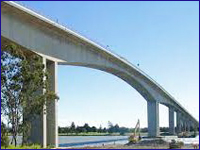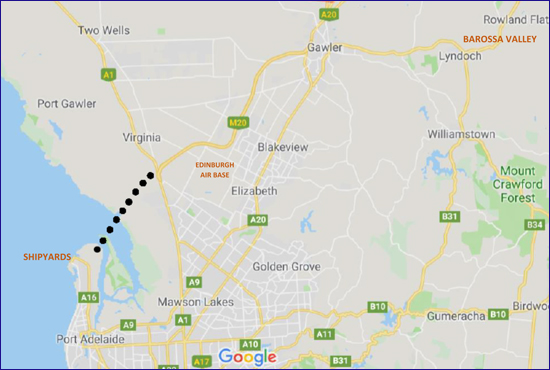Part 1
Without doubt, South Australia’s biggest ever public policy failure was the abandonment in 1970 of the MATS Plan (Metropolitan Adelaide Transport Study). The MATS Plan was a world-class road network for Adelaide’s future transport needs servicing a vibrant, emerging city. As a result of that ill-fated decision 50 years ago, SA has suffered incalculable cost, congestion and inefficiency due to its inadequate road system.
At that time, I was working for the SA Highways Department as a Laboratory Technician in the Department’s Materials, Research & Testing Laboratories at Northfield. Our then Commissioner Keith Johinke and all his staff were at the forefront of road transport planning and innovation. The excitement was palpable. Then came a change of government and the announcement that the MATS Plan was to be cancelled. It was an insane decision. All the land for the new road corridors had been acquired and the project was ready to go. So distressed was Commissioner Johinke by this announcement, he refused to sign the papers for the project’s cancellation, leaving it to an underling to carry out the Minister’s orders. The Department never recovered. Nor did Adelaide’s road transport system. I left the Department 5 years later to go into the private sector as did many others. In the 1980s the Department merged with a couple of other government departments and changed its name. A sad end to a once great institution.
Let’s not make that same ‘future planning’ mistake regarding the needs of the new submarine project which has just been announced. An industry sector this size is going to need a massive amount of support industries, including manufacturing, commercial, retail, education, housing, health, and other professional services.
In 1955, another great South Australian visionary, Sir Tom Playford, oversaw the growth and development of SA identifying that one key element for successful growth – cheap land.
The support industries for SA’s new maritime sector will need two things – affordable land, and easy ‘MATS Plan’ style access to the shipyards. Do not underestimate the importance of transport access.
Adelaide’s north can provide the land, and a new world-class gateway bridge over the Port River can connect the naval precinct with the northern Adelaide plains. Such a bridge and road system – perhaps even a rail line down the middle – would provide essential access to housing, supply chains and tourism opportunities – not to mention a ten-minute drive from the Edinburgh military air base.
The cramped suburbs around Port Adelaide are already under unsustainable pressure. Grand Junction Road is at maximum capacity. More traffic congestion, air pollution, the destruction of bio-diversity (bulldozing tree-lined streets and low-density housing) or increasing pressure on electricity, water, sewerage, or stormwater infrastructure, in other words more urban densification, would be a disaster.
One thing is certain, the new naval industry will need support systems. We don’t want to be spending countless billions of dollars retrofitting like South Road or the Southern Expressway debacle.
The Federal Government has given South Australia a new multi-billion industry. The SA State Government now needs to respond by opening up Adelaide’s north to supply this industry. Over the next 30 years tens of thousands of direct and indirect jobs are there for the taking.
In 2013, I was elected to parliament on a platform of “every family, a job and a house”. If every family had a job and owned a house, I argued, the benefits to the state and the nation would be great indeed. Clearly, a lot of people agreed with me.
Adelaide as the new maritime defence industry capital of Australia has the opportunity to provide ‘every family with a job and a house’. Let’s not blow it.
Part 2
 Last week in Part 1 of our MATS Plan Revisited report, we looked at connecting Adelaide’s new maritime defence precinct with the northern Adelaide plains via a new gateway bridge over the Port River. An industry sector this size we said was going to need a massive amount of defence procurement support, including manufacturing, commercial, retail, education, housing, health, and other professional services. In Part 2 of our proposal, we connect these support industries with long-haul freight infrastructure.
Last week in Part 1 of our MATS Plan Revisited report, we looked at connecting Adelaide’s new maritime defence precinct with the northern Adelaide plains via a new gateway bridge over the Port River. An industry sector this size we said was going to need a massive amount of defence procurement support, including manufacturing, commercial, retail, education, housing, health, and other professional services. In Part 2 of our proposal, we connect these support industries with long-haul freight infrastructure.
One thing is for sure – there will be a lot more freight and a lot more heavy vehicles on our roads as a result of this announcement.
“Fatal crash closes freeway”
This has become an all too familiar news headline in Adelaide.
Whether it’s taking children to school, taking farm produce to markets or long-haul interstate freight, road safety is paramount.
My first project when I began working at the SA Highways Dept in 1969 was the new SE Freeway. To be fair to the government of the day, when it designed the freeway, it did not expect the level of residential development to take place that has occurred since. The Adelaide Hills has become one of the fastest growing urban areas in the State and commuter traffic on the SE Freeway has increased exponentially. Long-haul freight transport has become incompatible with that level of commuter traffic. Truck drivers dislike the current SE Freeway situation as much as commuters.
A solution is available. A solution that takes trucks and semi-trailers off the freeway, off Portrush Road, off Hampstead Road, off Grand Junction Road and will get freight to the shipyards and new northern precinct quicker, safer and cheaper.
First let’s put things into perspective. Long-haul freight transport on the SE Freeway is mainly coming from Melbourne – a 740km journey. A new north-bound road from Murray Bridge, connecting to the existing Sturt Highway at the new $200m Truro by-pass would deliver freight to the northern Adelaide development precinct by-passing the SE Freeway and Adelaide’s suburban roads completely.

While adding approximately 70 kms to the overall journey – less than 10% of the distance from Melbourne – this non-stop route would not increase the journey-time. Adelaide’s suburban road congestion and approximately 30 sets of traffic lights between the Tollgate and Port Adelaide reduces freight transport to a snail’s pace.
According to the Bureau of Infrastructure, Transport and Regional Economics (Report No 148), the cost of building new highways in Australia is approximately $5m per lane per kilometre. A new 90 km four-lane Murray Bridge – Truro highway would therefore cost around $2bn. The safety benefits of such a project however would be incalculable and the cost of building the road would be recouped through increased productivity, fewer accidents and less suburban road maintenance.
To summarise these two MATS Plan Revisited reports, the recent nuclear submarine announcement has changed everything.
This once-in-a-lifetime opportunity to reset the State will deliver tens of thousands of direct and indirect jobs – significantly making up for the loss of Holden’s car manufacturing plant.
The new maritime defence project is a $100bn endeavour spread over the next 30+ years. Again, to put things into perspective, spending a small portion of that amount to ensure the project works properly makes good sense. A new gateway bridge and a new Murray Bridge to Truro connection, should be included in the overall cost of the maritime defence project.
As stated in Part 1 of this proposal, SA has been blessed with two great infrastructure visionaries in (former Premier) Tom Playford and (former Commissioner of Highways) Keith Johinke. Perhaps we could name the above infrastructure projects after each of them.
